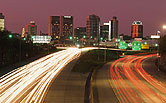Could a Noisy Neighborhood Make You Fat?
Constant exposure to traffic, trains and planes may add inches to your waist, researchers report.
Exposure to noise from traffic, trains and planes may be linked to a burgeoning belly, Swedish researchers report.

The increased risk of a larger waist rose with the number of sources of noise someone was exposed to at the same time -- from 25 percent for those exposed to only one source to nearly double for those exposed to all three sources, the scientists added.
"Long-term exposure to traffic noise may affect our metabolism and lead to abdominal obesity," said expert.
"Traffic noise should be recognized as an important environmental health hazard that needs to be taken into consideration in urban planning," expert said.
Expert cautioned that this is an observational study, so no definitive conclusions can be drawn about cause and effect between traffic noise and abdominal obesity.
Traffic noise, however, may be even more harmful to health than was previously known, expert said. Earlier research has shown associations between traffic noise and high blood pressure and heart attacks.
"But since abdominal obesity is a risk factor for many diseases, such as heart disease, diabetes and cancer, and more and more people live in densely populated areas in close vicinity of large roads, railways and airports, noise constitutes a serious public health threat," expert said.
Expert said, "At first, the idea that noise might make us fat or, specifically, increase fat around our middles where it is most dangerous, seems farfetched."
Studies of association like this new one are notorious for revealing correlations that aren't about cause and effect, expert said. "Noise exposure, for instance, might be more prevalent among poorer neighborhoods where food choices are poorer as well, and that could be the real cause of increased abdominal fat".
This new study, however, did a careful job of controlling for such alternative explanations, he said.
"There is a plausible explanation -- noise is stressful, stress can alter levels of hormones and hormonal imbalance can influence where in the body excess calories are deposited. In addition, these findings agree with other work indicating that environmental cues may influence what and how much we eat," expert said.
For the study, the researchers collected data on more than 5,000 people living in five suburban and rural areas around Stockholm who had taken part in the Stockholm Diabetes Prevention Program from 1992 to 1998.
Between 2002 and 2006, when they were between the ages of 43 and 66, they completed a questionnaire covering lifestyle, current state of health, levels of psychological stress, insomnia and job strain. Researchers also asked about noise from traffic, trains and planes.
In addition, the study participants had their blood pressure checked and were tested for diabetes. Researchers also measured their waist and hips, along with overall obesity.
The researcher's team found that among women there was a 0.08-inch increase in waist size linked to every additional 5 decibels in traffic noise exposure.
Among men, there was a link between environmental noise and waist-to-hip ratio. Researchers found an increase in waist-to-hip ratio of 0.06 inches for every additional 5 decibels in traffic noise exposure.
"The main mechanism underlying this association is that traffic noise may increase the levels of a stress hormone called cortisol, which is known to stimulate the accumulation of fat in the abdominal area. Noise-induced sleep disturbance may also play a significant role," expert said.
According to the study, these findings were not influenced by socioeconomic factors, lifestyle or exposure to air pollution. But age was a significant factor, with the association between belly fat and traffic noise only found for those younger than 60.
Said expert: "Whether noise contributes to central obesity and metabolic risk is not certain, but possible. There are reasons, however, for those with power over policies and environments where people and noise come together to do what they can to tone it down."
Source: U.S. Dept. of Health & Human Services
- 312 reads
Human Rights
Fostering a More Humane World: The 28th Eurasian Economic Summi

Conscience, Hope, and Action: Keys to Global Peace and Sustainability

Ringing FOWPAL’s Peace Bell for the World:Nobel Peace Prize Laureates’ Visions and Actions

Protecting the World’s Cultural Diversity for a Sustainable Future

Puppet Show I International Friendship Day 2020

